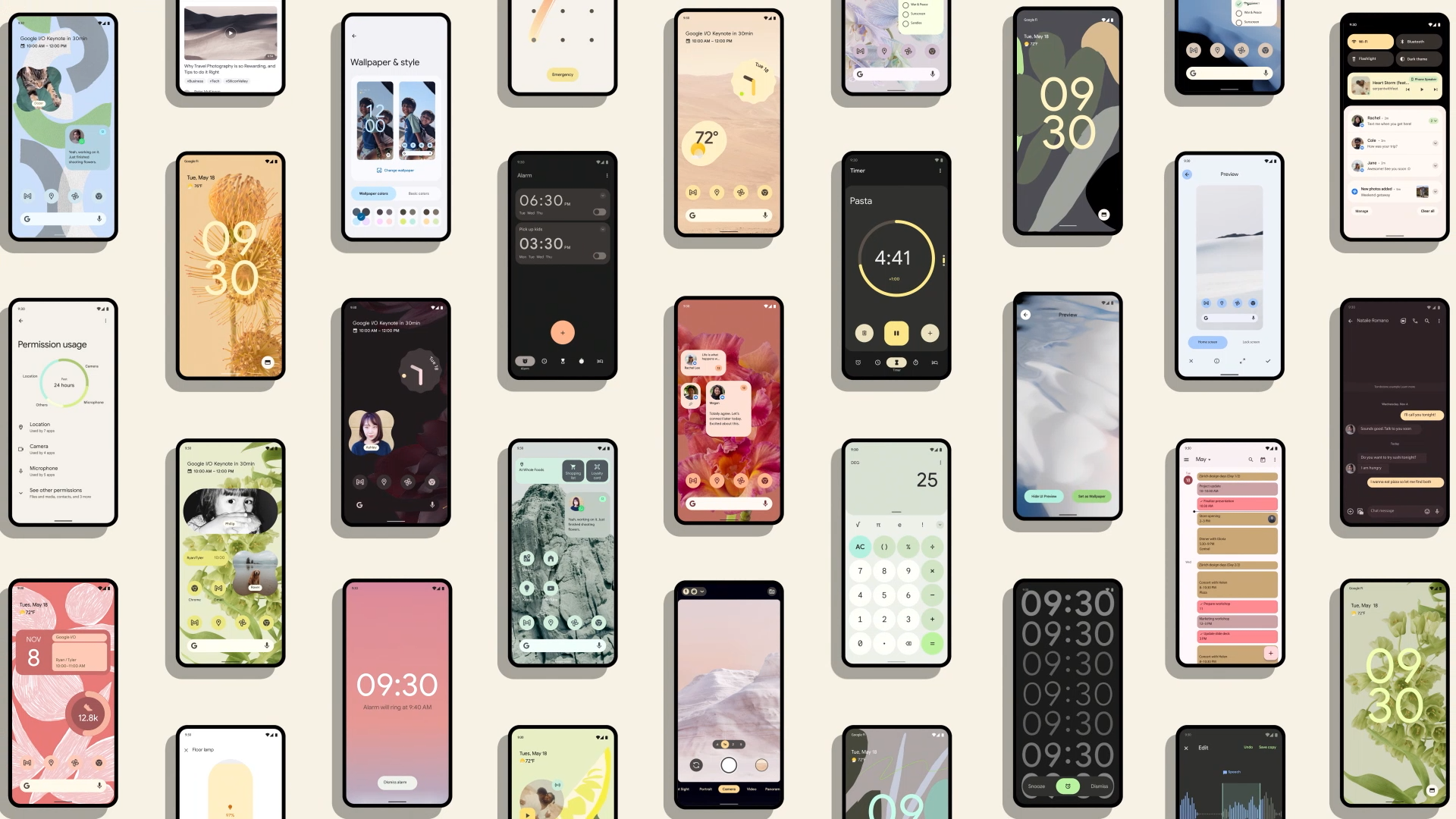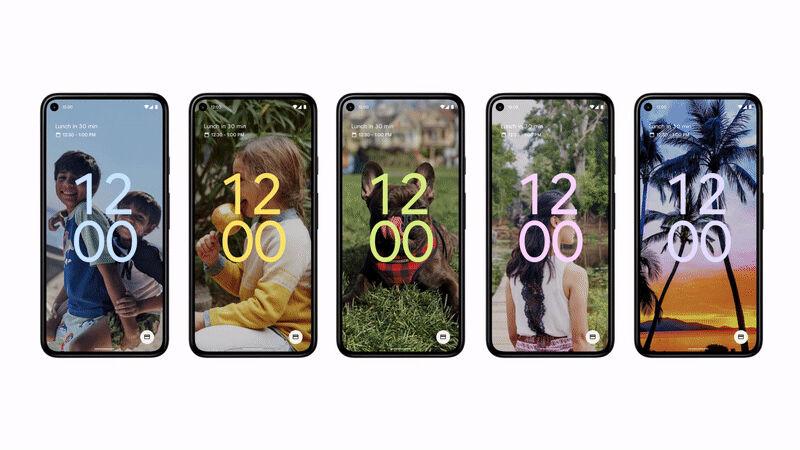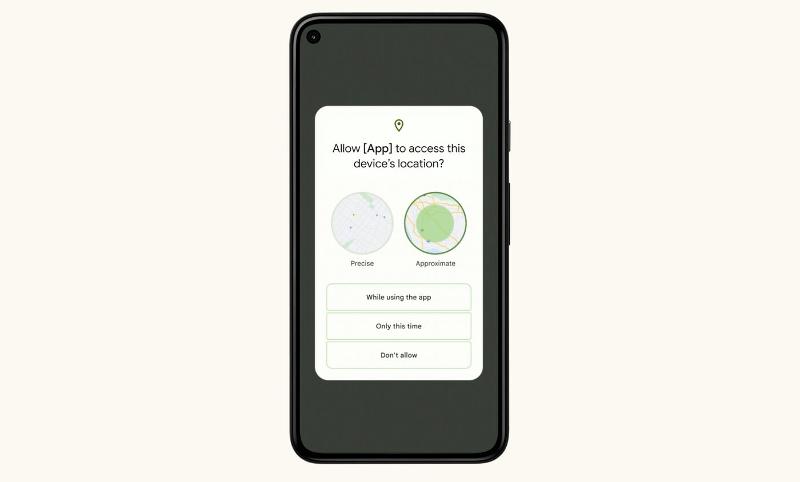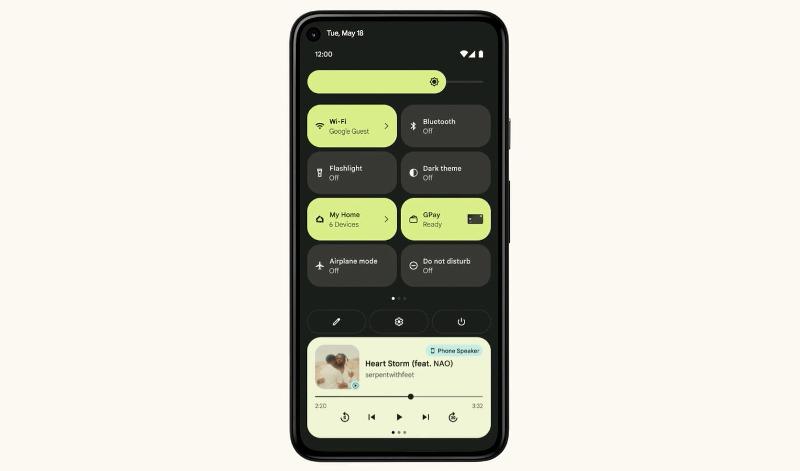Google updates its Android operating system each year, introducing new features and designs that keep the software in fine fettle, and the new version for 2021 is Android 12.
Launching later this year, Android 12 will bring about a whole new design language and a host of new privacy features, among other improvements, to Google’s device ecosystem.
So, what will appear in Android 12 when it arrives later this year? Here’s everything Google has revealed, along with how you can join the beta.
When will Android 12 be released?
Google hasn’t confirmed a specific release date for Android 12, but you should expect it to arrive in autumn/fall, likely alongside the Pixel 6.
The latest version of Android is usually first seen in developer previews in March, then publicly previewed at Google’s I/O event in May, with public beta versions releasing shortly afterwards and the final, full release of the software coming in autumn.

The first developer preview of Android 12 went live on 18 February, granting developers their first chance to really sink their teeth into the update (with the second preview touching down on 17 March and the third on 21 April), before Google officially revealed the new OS at its annual I/O developer conference on 18 May, launching its first public beta at the same time (the second public beta was then released on 9 June, the third arrived on 15 July and the fourth landed on 11 August).
In the past few years, Android has adopted the following release pattern:
Android 9 Pie
- First public beta: 8 May 2018
- Full version release: 6 August 2018
Android 10
- First public beta: 7 May 2019
- Full version release: 3 September 2019
Android 11
- First public beta: 10 June 2020
- Full version release: 8 September 2020
Android 12
- First public beta: 18 May 2021
- Second public beta: 9 June 2021
- Third public beta: 15 July 2021
- Fourth public beta: 11 August 2021
What about the Android 12 beta?
Android 12 beta 4 is live now, with a focus on platform stability and will likely be the final major pre-release update before Android 12 officially arrives. If you want to try it out for yourself, you’re going to need a compatible device and to head on over to our how-to guide for a breakdown of the download and installation process.
Beta access is easiest from a Pixel phone (Pixel 3/3 XL and newer) but is rolling out to select devices from several other mobile manufacturers too. Here’s a list of other phones compatible with the Android 12 beta:
Which phones will get Android 12?
This is where things can get complicated. Android still suffers from horrendous fragmentation which means some phones get the new software straight away, others follow on weeks or months later, while a fair chunk won’t get it at all.
If you want to guarantee moving to the next version of Android, then you’ll want to buy one of Google’s own Pixel phones, such as the Pixel 5, Pixel 4a or Pixel 4a 5G, all of which get preferential treatment due to the fact that Google knows the exact make-up of each phone’s hardware configuration and software.
Any phones on the Android One platform, such as many Motorola and Nokia handsets, also get the newer versions quickly, although usually only for up to two years after they were first released (in most cases).
You should also be able to expect swift(er) updates to the new OS from any of the brands listed above for the Android 12 beta, especially on more recent devices.
You can read our guide to the best brands for Android updates to give yourself a clearer indication of whether (and when) your particular device will make the leap. Of course, you can also get in touch with the manufacturer’s customer support, as they may be able to help too.

What’s new in Android 12?
One of the main areas of excitement for any new version of Android is, of course, which new features Google introduces.
Here are all the features confirmed so far for the new OS, from Google’s official announcement and the various developer previews and betas now out there:
Material You
The biggest change concerns how Android is going to look moving forwards: Material You.
That’s Google’s name for the new design language that runs through Android 12 on its Pixel phones, and will eventually roll out across other Google hardware.
The OS is far more colourful, with customisable colour palettes that run throughout the phone, from the lock screen to your actual apps.
You can set these five-colour palettes yourself, or let the phone create one for you by dynamically picking the colours out from your phone’s wallpaper.

Google says that when Material You debuts on Pixel phones this autumn the custom palettes will work across every Google app and that eventually, third-party apps will also be able to take advantage.
Icons and interfaces have been rounded off throughout, with circles, squircles, and straight-up squiggles appearing all over the place.
This new design will be a Pixel-exclusive at first, but it’s hard to know how much of the design will ever filter through to the Android skins used by Samsung, Xiaomi, and other manufacturers.
Faster motion and animations
The interface is also more dynamic and responsive. Turn the screen on using the power button and the light will ripple out away from the button, while if you have no notifications then your lock screen clock will expand to fill the space.
All of this will be smoother and faster too, thanks to under-the-hood improvements that have reduced the CPU time needed for core system services by up to 22%, and reduced the system server’s use of big cores by up to 15%.
New privacy features
Beyond the design, the biggest set of changes to Android 12 are all about privacy and security, most of which first arrived in the second public beta.
First up is a new Privacy Dashboard, which is intended to be a one-stop-shop for all of your data privacy; letting you know what data was accessed, when, and by which apps – with the option to revoke app permissions right there and then too.
New microphone and camera icons indicate when an app is using either, so you aren’t caught unawares.
If you want to be even more careful, there are new Quick Settings toggles to entirely block camera and/or microphone access for all apps at once for guaranteed privacy.
There’s also a new ‘approximate location’ permission so that you can give more vague location data to apps that don’t need to know exactly where you are, like your weather app.

In a message first sent to Android developers in early June, it’s also been revealed that Google intends to give users the option to opt-out of ad tracking, meaning such users’ Advertising ID (which is used for ad tracking purposes) won’t be supplied to developers who request and they’ll instead simply receive a string of zeros.
This follows on from a similar move Apple made with the release of iOS 14.5, where apps need to ask permission to track user information for the purposes of personalised ads. The obvious difference here is Google’s opt-out approach versus Apple’s opt-in, but for users made aware of the change, it will add a greater layer of privacy when it comes to ad tracking that is undoubtedly appreciated.
New way to access Google Assistant
Google has added yet another way to access the Google Assistant: a long-press on the power button.
Since this is already used in all sorts of ways by different phones, expect this to simply become another of several options for this button shortcut.
Quick Settings
Back on Quick Settings, the menu has been redesigned as part of wider tweaks to the notification tray.
Most excitingly, there are new Quick Settings options to access your Google Home device settings and Google Pay.

ChromeOS integration
Google is also keen to build up its wider device ecosystem, so Android 12 will have tighter integration with Chromebooks and other ChromeOS devices.
A single tap on the phone will facilitate the unlocking of a nearby Chromebook, while you’ll also get all of your chat notifications there in ChromeOS, and be able to access photos from your phone on your laptop.
Android TV remote
Android 12 will also link more closely to Android TV.
Android 12 phones will be able to operate as a TV remote for all Android TV devices, letting you use the phone’s microphone for voice search, or type using your phone’s keyboard.
Digital car key
Google is also the latest company to work on using your phone as a car key.
Using a combination of NFC and UWB (ultra-wideband) tech, you’ll be able to use your phone as a secure key to lock, unlock, or start your compatible car, and you’ll even be able to share keys securely with friends or family.
Since this relies on UWB, the digital car key will be limited to phones with that hardware – in this case, “select Pixel and Samsung Galaxy phones,” likely including the Galaxy Note 20 Ultra, Galaxy S21+ and Galaxy S21 Ultra, so far the only Samsung phones with a UWB chip.
Scrollable screenshots
For a while it looked like this simple tool would appear in Android 11, as companies like OnePlus, Huawei and Samsung already have the feature in their versions of the operating system.
But it didn’t quite make the cut in time, so we’re glad it’s arriving on Android 12, granting you the ability to capture images that encompass the entire page of a site or app, not just what you can see on the display.
The feature was first made available to users in the third public beta, released in July 2021, with a “Capture more” button appearing every time you snap a screenshot with content that doesn’t fit on screen. Google also reassured developers that these should work in most apps without them needing to change their app’s code.
App Search
Another addition from the third beta is “a new high-performance on-device search engine,” which lets users search for indexed and ranked apps and app data on their devices.
‘Conversations’ widget
Another addition is the ‘Conversations’ widget, which will consolidate missed calls, status updates and messages from multiple platforms (including Facebook Messenger and WhatsApp) for a single contact (or potentially a small group of contacts).
System-wide camera improvements
Android doesn’t natively support quad or nona-binning sensors (as on the likes of the Samsung Galaxy S21 series), so native support for such hardware across apps is now being implemented within Android 12, which should result in better quality imagery between different apps that utilise the camera.
Cameras will also benefit from custom manufacturer shooting effects (like HDR, bokeh etc.) across more apps outside of a phone’s camera app too, thanks to changes in how Android handles its CameraX library and Camera2 API extensions.
Rich content insertion
The ability to copy and paste richer bodies of content (such as images, videos and audio) by way of a new API that accepts content from multiple sources: clipboard, keyboard or drag-and-drop, in order to move it between apps.
Haptic-coupled audio effects
Haptic feedback (precise vibrations) governed by audio files, which can be used to control vibration strength and frequency to create more immersive experiences; something we’ve already seen from the likes of select Sony and Honor phones. Examples provided by Dave Burke, VP of Engineering for Android, include a video calling app using custom ringtones to identify a caller through haptic feedback or you simulating the sensation of rough terrain in a racing game.
Immersive Mode improvements for gesture navigation
Immersive Mode is effectively full-screen mode, where the notifications bar and on-screen navigation buttons are temporarily hidden while an app occupies the entire screen.
In Android 12, aside from when gaming, all other full-screen/immersive apps/experiences (such as video playback, reading, photo galleries etc.) will be easier to exit out of with a simple swipe; in an effort to better accommodate Android’s prior move to gesture navigation over button navigation, by default.
More of Android updated through Google Play
A continuation of Project Mainline, Android 12 will better allow for various components of Android to be updated via Google Play going forward, without the need for subsequent full OS upgrades.
Optimisation for tablets, foldables and TVs
Android on tablets is famously ‘meh’, filled with incompatibilities and user interface issues borne from poor app optimisation. New tools should help developers build better Android 12-based experiences for Android tablets, foldables and TVs and includes a new Android 12 for TV preview to tinker with too.
